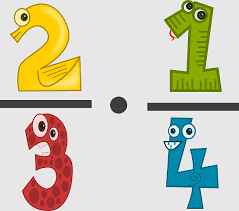Solved Examples: Fractions & Decimals | Quantitative Aptitude for SSC CGL PDF Download
Types of Decimal and Fraction
The decimals is of two types:
Non-recurring decimal or terminating decimal
As the term suggests, non-recurring refers to numbers that do not repeat and instead terminate, such as 0.5, 0.25, and 0.125. To convert these fractions into decimals, you simply divide the numerator by the denominator. For example, if you want to convert 1/4 into a decimal, you divide 1 by 4, resulting in the answer 0.25.
Converting 0.5 into fraction
0.5 = 5 / 10
= 1 / 2, or
converting 1/4 into Decimal
Dividing 1 by 4 we will get
= 0.25
Recurring decimal or non-terminating decimal
The term itself implies that recurring numbers repeat indefinitely and do not terminate, such as 0.333..., 0.545454..., and so on. To convert these fractions into decimals, you simply divide the numerator by the denominator. For example, if you wish to convert 1/3 into a decimal, you divide 1 by 3, resulting in the answer 0.333...
Converting 1/3 into decimal
Dividing 1 by 3 we will get
= 0.333..
Examples
Example 1: Find the value of .114 * .114 + 2 * .114 * .044 + .044 * .044
(a) 0.024964
(b) 0.201232
(c) 1.306956
(d) 30.69
Ans: (a)
To calculate the expression .114 * .114 + 2 * .114 * .044 + .044 * .044, we can simplify it step by step:
.114 * .114 = 0.012996
2 * .114 * .044 = 0.010032
.044 * .044 = 0.001936
Adding these values together:
0.012996 + 0.010032 + 0.001936 = 0.024964
Therefore, the value of .114 * .114 + 2 * .114 * .044 + .044 * .044 is approximately 0.024964
Example 2: Eleven thirtieth of a number is 12 more than one fifth of a number. Find the number.
(a) 45
(b) 60
(c) 55
(d) 72
Ans: (d)
11/30x – 1/5x = 12
5/30x = 12
1/6x = 12
x = 12 * 6
x = 72
Example 3: A number is as much greater than 5001 as it is less than 10001. Find the number.
(a) 7741
(b) 7501
(c) 7546
(d) 7549
Ans: (b)
Let the number be x
Given, (x - 5001) = (10001 - x)
= x + x = 10001 + 5001
2x = 15002
x = 7501
Example 4: Find the sum of all the prime number between 10000 and 10100?
(a) 110424
(b) 110648
(c) 110651
(d) 110650
Ans: (c)
The prime numbers between 10000 and 11000 are:
10007, 10009, 10037, 10039, 10061, 10067, 10069, 10079, 10091, 10093, and 10099
Therefore, the sum = 10007+ 10009+ 10037+ 10039+ 10061 + 10067 + 10069 + 10079 + 10091 + 10093 + 10099 = 110651
Example 5: What least number is there in the place of * so that the number 9041705*4 is divisible by 7?
(a) 3
(b) 2
(c) 4
(d) 5
Ans: (d)
9 + 0 + 4 + 1 + 7 + 0 + 5 + 4 = 30
The nearest number divisible by 7 is 35
7 * 5 = 35
Therefore, the missing number is 35 – 30 = 5
Hence, the number is 904170554
Example 6: If 122.21x = 0.00122y, then find the value of ((y - x) / (y + x)).
(a) 6110439 / 6110562
(b) 6110439/6110561
(c) 6110561/6110500
(d) None of the above
Ans: (b)
x/y = 0.00122 / 122.21
= 000.122 / 12221
= 122 / 12221000
= 61 / 6110500
x = 61 , y = 6110500
y - x = 6110500 - 61 = 6110439
y + x = 6110500 + 61 = 6110561
(y - x) / (y + x) = 6110439 / 6110561
Example 7: Find the value of x in the given expression: 310420/1009 = x/ 0.0075
(a) 1.8
(b) 2.30
(c) 3.5
(d) None of the above
Ans: (b)
310420/1009= x/ 0.0075
= 1009x = 310420 * 0.0075
= 1009x = 2328.15
x = 2328.15/1009
x = 2.30
Example 8: What percent of 1000.008 is 10320.408?
(a) 1130.25%
(b) 1032.032%
(c) 1030%
(d) 1032%
Ans: (b)
Let x% of 1000.008 = 10320.408
Then, x/100 * 1000.008 = 10320.408
1000.008x = 1032040.8
x = 1032040.8/ 1000.008
x = 1032.032%
Example 9: The sum of two numbers is 198. If one-third of the one exceeds one - seventh of the other by 8, find the smaller number.
(a) 65
(b) 68
(c) 70.8
(d) 76.2
Ans: (d)
Let the number be z and (198 – z). then,
⇒ z/3 – (198 – z )/7 = 8.
⇒ 7z – 3(198 – z) = 168
⇒ 10z = 762
⇒ z = 76.2
Example 10: Find a number such that when 18 is subtracted from 8 times the number, the result is 12 more than twice the number.
(a) 5
(b) 10
(c) 15
(d) 20
Ans: (a)
Let, the number be z, Then,
8z – 18 = 2z + 12
⇒ 6z = 30 ⇔ z = 5.
Hence, the required number is 5.
|
317 videos|299 docs|156 tests
|





















